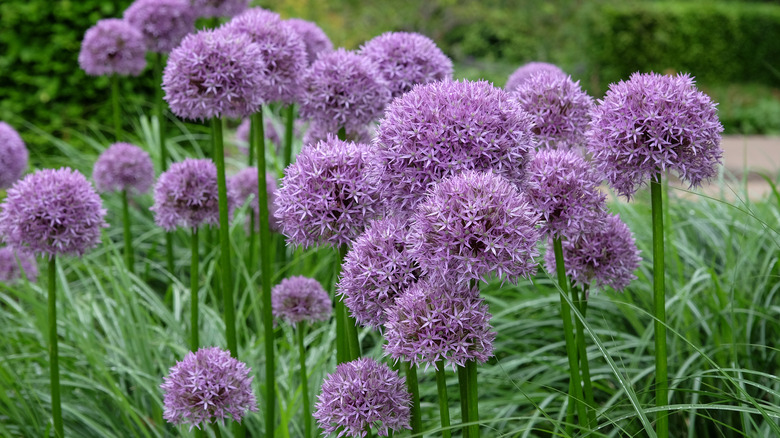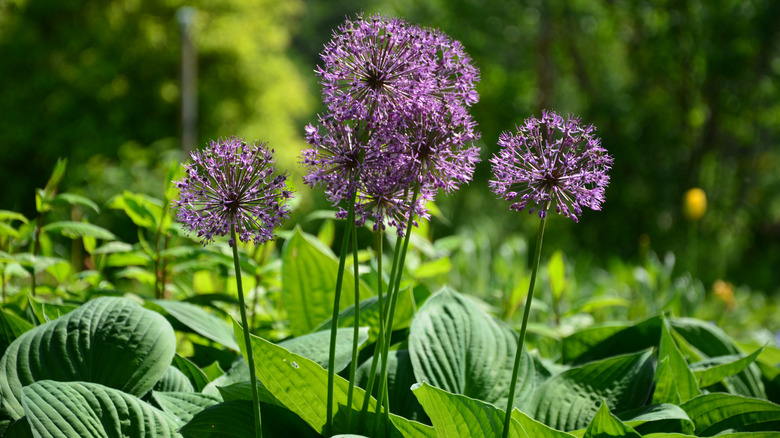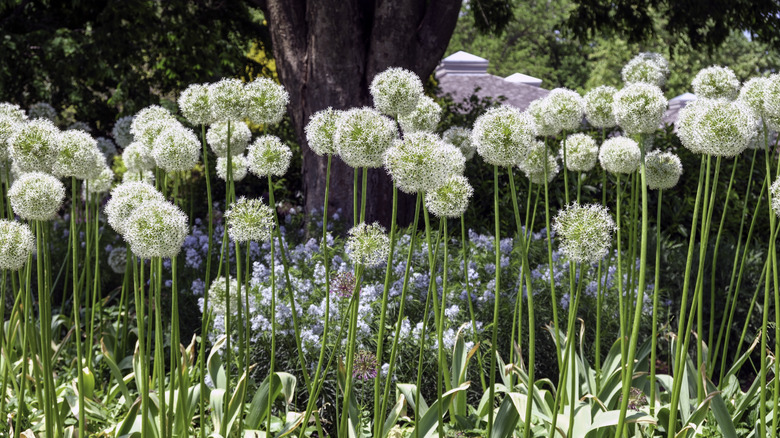What Variety Of Allium You Should Be Growing For The Largest Possible Blooms
Alliums help fill that awkward gap in blooms that comes after the flush of daffodils and tulips in the spring, before the summer annuals and perennials step in. For a brilliant display of the largest possible allium flowers, gardeners frequently turn to giant alliums, such as Allium giganteum, Allium christophii, and Allium stipitatum cultivars. Stately and erect, giant alliums are in the same family as onions, garlic, and chives. (In fact, you know it's time to plant alliums when people start talking about planting garlic in the fall.) While you may notice the same familiar smell when you're working with alliums, they're not grown for culinary purposes.
Often referred to as ornamental onions, alliums are grown as surprisingly hardy and dramatically impactful decorative plants. Giant alliums are frequently used to create a delightful display of extraordinary blooms. With vigorous flower heads that rise to five feet tall, giant alliums are topped with six to eight-inch spheres of tiny star-shaped florets. They come in a wide range of colors, including shades of white, yellow, purple, and red.
Generally hardy in USDA zones 4 through 8, one of the best features of giant alliums is that the flower heads dry in place when the plant is done blooming, leaving you with seed heads that are equally as striking as the flowers. If you leave them in place, they'll continue to add texture and structure to your garden design.
Selecting giant alliums for a striking spring display
With names like Gladiator, Globemaster, and Ambassador, it's only natural to feel a little intimidated by giant alliums, but don't let their impressive size deter you. Allium flowers come in various heights and sizes with different bloom times, with enough varieties to keep your garden flowering from late spring to early summer. Depending on their size, alliums can be used as everything from backdrops and borders to the main focal point in a mass planting.
When you're looking for a captivating display with some giant vibes, the alliums with the largest blooms come from popular cultivars. Giant allium species include hybrids like 'Globemaster' (which is a cross between Allium giganteum and Allium christophii) and white alliums like Mount Everest. These can be grown separately or mixed, depending on your design and aesthetic. With the proper placement and companion plants, alliums can be used in almost any type of landscape.
Another large white allium to consider for a dependable bloom that adds height and drama to your garden is Allium stipitatum 'White Giant.' This ornamental onion gets up to four feet tall with six to eight-inch flowers. For slightly smaller spaces, the four-inch blossoms on Allium aflatunense 'Purple Sensation' are a good choice. With bright purple flowers on two to three-foot stems, Purple Sensation makes an impact. Paired with plants like hostas, alliums create an extra dimension in your landscape design during their bloom period by adding color, texture, and height.
Follow these practical tips to care for allium cultivars
One of the biggest advantages of growing alliums is that they're resistant to deer, so you don't have to worry about taking measures to protect them. They do attract pollinators, though, which is a good reason for anyone with a few fruit trees to grow them. Giant alliums are generally planted in the fall, a few weeks before the ground freezes. To determine how deep to plant allium bulbs, use the same general rule for all flower bulbs, which says to plant them two to three times their height. For giant allium bulbs, this usually means about 5 to 6 inches deep.
After you plant allium bulbs, water them thoroughly. After that, all you have to do is wait until spring for them to start growing again. Whether you choose to plant small groupings of five to seven bulbs or in mass plantings, each giant allium plant needs plenty of space to grow. Plant them approximately twelve inches apart in an area that receives full sun.
The most important factor to note is that they require well-draining soil. This is good news if you have sandy soil, but if you are planting in heavy clay soil, you may need to consider other options, like amending your soil or growing allium in an extra-large container. Wherever you put them, you may also need to provide support by staking the plants so they can hold up their giant heads.


